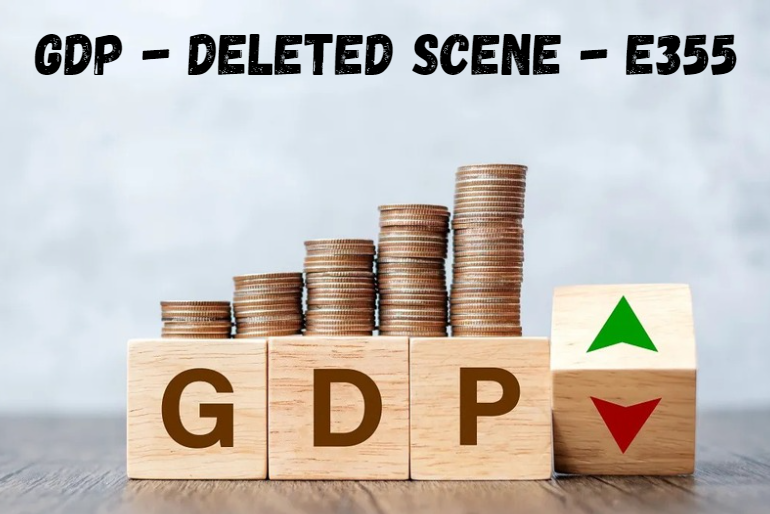GDP – Deleted Scene – E355 presents an intriguing intersection between economic storytelling and media production, showcasing how Gross Domestic Product (GDP) discussions can be woven into media for a broader understanding of economic landscapes. By delving into this unique scene and its background, we explore not only why it was omitted but also what it potentially adds to the audience’s comprehension of economic factors and the role of GDP in influencing individual lives, government policies, and global relations.
What Is GDP?
Gross Domestic Product, or GDP, is the total monetary value of all finished goods and services produced within a country’s borders over a specified period, usually annually or quarterly. As a primary measure of economic performance, GDP helps indicate the economic health of a nation, reflecting both productive activity and economic capacity. The relevance of GDP extends to everyday lives as it influences employment opportunities, income levels, and government spending, impacting society’s overall well-being.
The Role of GDP in Economics
GDP holds a central place in economics as it provides a snapshot of a country’s economic activity and stability. Economists, policymakers, and investors track GDP data to make informed decisions, understand market trends, and gauge national prosperity. A growing GDP signifies economic progress, often corresponding to increased job creation and higher incomes, while a shrinking GDP indicates a possible recession or economic distress, prompting measures to stabilize the economy.
E355 Deleted Scene Background: Analyzing the Context
The deleted scene titled “GDP – Deleted Scene – E355” might have contained valuable information on GDP or an economic situation integral to the storyline. Such scenes often contribute additional depth to economic topics but may be removed due to runtime constraints or a shift in focus. In many cases, scenes related to economics are considered highly informational and technical, potentially challenging general viewership engagement.
Reasons for Deleted Scenes in Media
Deleted scenes often result from a need to keep the narrative flowing or due to runtime limitations. Scenes that delve into technical economic topics, like GDP or financial indicators, may be deemed too detailed or tangential to the main storyline for a general audience. However, these scenes can provide insights into the economic realities facing characters or settings, enriching the story’s realism and educational value.
Contextual Analysis of E355: Exploring the Potential of Deleted GDP Insights
For viewers interested in economics, the E355 GDP scene may offer an enriched understanding of the narrative’s socioeconomic background. By illustrating GDP-related elements, such as economic downturns or growth periods, this scene would have allowed for a more profound perspective on economic dynamics affecting the characters and storyline. Although removed, understanding the scene’s intended purpose can bridge gaps in the narrative for economically inclined audiences.
How GDP Measures Economy
GDP is typically calculated through three main approaches:
- The Production Approach: Summing up the value added at each production stage.
- The Income Approach: Adding up all earnings in the economy, including wages, interest, rents, and profits.
- The Expenditure Approach: Adding up all expenditures made on final goods and services, including consumption, investment, government spending, and net exports.
Each of these approaches contributes to a holistic view of the economy’s productivity, efficiency, and consumer behavior patterns, painting a complete picture of national and individual prosperity.
Types of GDP: Nominal, Real, and Per Capita
Understanding the distinctions within GDP helps in grasping its practical implications:
- Nominal GDP: The GDP calculated at current market prices without adjusting for inflation, representing the face value of goods and services.
- Real GDP: Adjusted for inflation, providing a more accurate picture of an economy’s true growth over time.
- Per Capita GDP: GDP divided by the population, giving insight into the average economic output per person and standard of living within a country.
Historical GDP Trends: A Global Perspective
Historically, GDP trends reveal the ebbs and flows of economic prosperity and recession across different regions. High-growth periods often follow technological advancements or policy reforms, while recessions frequently stem from economic imbalances, natural crises, or market bubbles. By understanding these trends, economists and analysts can forecast future economic challenges and potential areas for policy intervention.
GDP’s Impact on Society
The effects of GDP stretch beyond economic numbers, influencing a country’s social, cultural, and political spheres. High GDP often correlates with better healthcare, improved education, and heightened infrastructure development, while low GDP might signal areas where public resources are limited. Moreover, GDP serves as a tool for comparison, guiding global organizations in resource allocation, development programs, and economic support for developing nations.
Understanding GDP Fluctuations
Several factors contribute to GDP shifts, including consumer spending, government policies, investment rates, and external trade balance. Economic cycles of boom and bust, influenced by internal and external forces, shape GDP trends. These fluctuations often reflect broader shifts in global demand, monetary policy adjustments, and geopolitical events that may either stimulate or suppress economic growth.
Analyzing the GDP – Deleted Scene – E355
The GDP – Deleted Scene – E355 could offer a nuanced exploration of economic indicators impacting society within the story. By highlighting GDP’s fluctuations and societal responses, this scene might bring to light the intricate relationship between economic growth and individual livelihoods, possibly showing how characters adapt to economic adversities or benefit from economic opportunities. This scene’s potential focus on GDP might enhance the storyline’s authenticity and realism.
Key Lessons from E355
Through the lens of E355, we can glean valuable insights into the implications of economic stability and growth for various stakeholders. Whether addressing economic hardships, policy responses, or community resilience, GDP-focused scenes reflect the real-life importance of economic awareness. Such insights contribute to a viewer’s understanding of economic resilience, individual and collective responses to growth, and the human element within economic metrics.
Future of GDP Analysis in Media
Media increasingly engages with economic topics as they become more central to global consciousness. By including GDP-related themes, storytellers can foster a more economically informed audience, potentially affecting viewer perceptions of fiscal responsibility, policy support, and personal financial literacy. Media narratives that integrate economic themes like GDP provide a more realistic portrayal of modern challenges, aligning fiction with lived experience.
Criticisms of GDP Measurement
Despite its widespread use, GDP has its limitations. Critics argue that GDP fails to account for income inequality, environmental degradation, and quality-of-life factors. As a purely quantitative metric, GDP overlooks qualitative aspects of economic well-being, leading to a narrower view of prosperity. These limitations have led some economists to advocate for complementary indicators that better reflect societal progress, such as the Human Development Index (HDI) or Gross National Happiness (GNH).
Economic Storytelling in Media
The storytelling approach in media plays a crucial role in simplifying and conveying complex economic concepts like GDP. Through characters and narratives, economic themes become relatable, illustrating abstract metrics in tangible ways. This approach aids viewers in grasping concepts like inflation, recession, or income disparity, bridging the gap between academic economics and real-world experience.
Frequently Asked Questions
How does GDP affect individual income? GDP growth generally correlates with increased employment and income levels, impacting individual purchasing power and overall economic welfare.
What causes GDP to fluctuate? GDP fluctuations result from shifts in consumer spending, government policies, investment trends, and external trade dynamics, reflecting economic cycles and market changes.
Why is GDP not the only measure of economic health? GDP focuses on production and output but lacks insight into income distribution, environmental impact, and societal well-being, making it a partial economic measure.
How does media representation of GDP impact public perception? Media portrayals of GDP can influence public understanding by highlighting economic conditions, government policies, and individual responses, shaping collective economic literacy.
Is there a way to measure quality of life beyond GDP? Yes, alternative measures like the Human Development Index (HDI) and Gross National Happiness (GNH) aim to encompass well-being aspects beyond GDP.
What is the significance of GDP in developing countries? For developing countries, GDP growth can signify progress, investment potential, and poverty reduction, often drawing international support and funding.
Conclusion
The exploration of GDP – Deleted Scene – E355 underscores the relevance of economic narratives in media. By understanding GDP’s impact and limitations, audiences gain a fuller appreciation of economic conditions shaping societies globally. This scene, while omitted, reminds us of the significance of economic insights and the importance of fostering economic literacy through diverse storytelling mediums.



